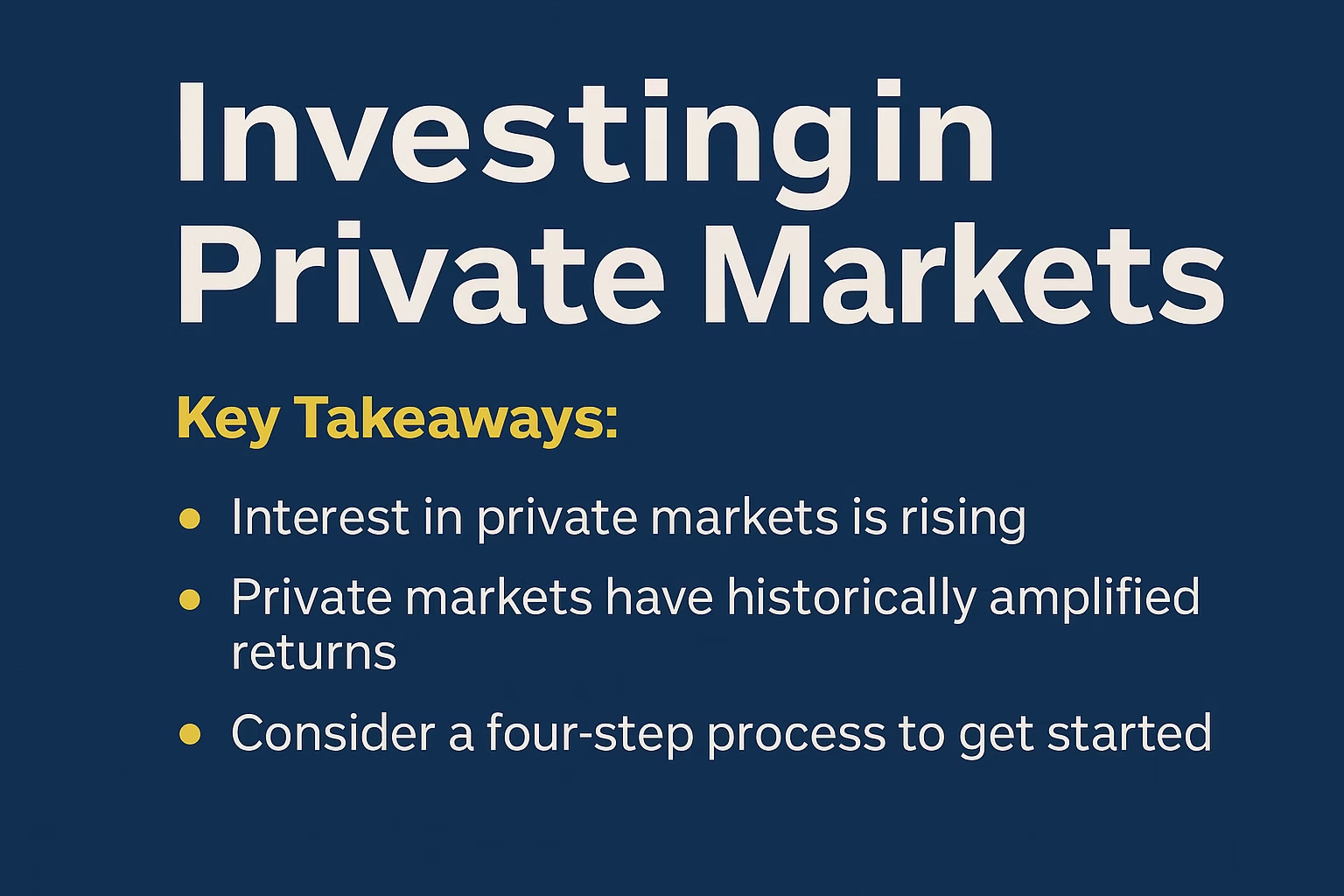📈 1. Introduction: The Rise of Private Markets
Investing in private markets—like private equity, private credit, real estate, and infrastructure—is no longer just for institutions. Today, retail and high-net-worth investors increasingly see value in stepping beyond public stocks and bonds. That’s because:
- Public companies are shrinking: large private firms (100+ employees) are up 46% in 30 years
- Meanwhile, global private credit has surged since the ’90s—banks now fund only ~10% of middle‑market loans, down from 70% in 1994
This shift means that investing in private markets can capture opportunities unavailable in public investing—if you follow the right plan.

🧭 2. Why Consider Investing in Private Markets?
🔸 Unique Return Streams
- Private equity offers long-term capital gains.
- Private credit tends to provide regular income.
- Real estate & infrastructure blend both, often with tax benefits.
🔸 Better Diversification
These assets have low correlation to public markets—helping reduce volatility
🔸 The Illiquidity Premium
Private assets reward investors with higher returns in return for lower liquidity—a well-documented phenomenon.
⚙️ 3. Four-Step Process to Start Investing in Private Markets
Follow this simple roadmap:
- Set Your Liquidity Budget
Decide how much cash you can lock away, given that many private investments have 3–10+ year horizons. - Choose the Right Exposures
- Private Equity: For growth-focused investors.
- Private Credit: For income seekers.
- Real Assets: For stability and tax benefits.
- Determine Allocation Size
Surveys show high-net-worth portfolios often allocate 5–10% to private markets; family offices average 42%
Infrastructure is favored for risk reduction; equity-focused investors lean into private equity - Pick the Right Investment Vehicle
- Closed-end funds: 7–10 year lockups.
- Interval/tender offer funds: Quarterly liquidity windows.
- Evergreen structures and 401(k) private-equity options are emerging
- Fund from Traditional Portfolios
Replace bond-like exposures with private credit; equity-like exposures with private equity—maintaining target risk profiles
🔍 4. Understanding Private Market Vehicles
🔹 Private Equity
High-growth companies seek investors before going public. Investors gain through value creation and eventual exits. Traditionally long-term.
🔹 Private Credit
Non-bank lending to companies. Offers floating-rate income and relatively stable cash flows .
🔹 Real Estate and Infrastructure
Tangible assets with income and capital appreciation, often enhanced by tax advantages like depreciation .
📚 5. Performance Snapshot & Risk Considerations
| Asset Class | 10‑Year Avg Return* | Typical Liquidity |
|---|---|---|
| Private Equity | ~15%+ (Preqin) | 7–10 years |
| Preqin Private Debt | ~8–12% | 3–7 years |
| RE/Infrastructure | ~7–10% | Varies |
| Public Equities | ~7–10% (MSCI ACWI) | Daily |
| Public Bonds | 2–4% (Bloomberg AGG) | Daily |
*Historical returns don’t guarantee future performance.
⚠️ Key Risks
- Illiquidity
- Fee structure & complexity
- Valuation opacity
- Extended investment horizons
🌍 6. Why Institutions Are All-in on Private Markets
- Europe: Largest private-equity deal region H1 2025
- Pensions & insurers are fueling private credit growth—Legal & General’s £20 bn partnership with Blackstone is a recent example
- BlackRock & others are integrating private assets into retirement savings like 401(k)s
- Alternatives are increasingly replacing traditional 60/40 portfolios
🛠️ 7. Getting Started as a Retail Investor
- Work with a trusted advisor specializing in alternatives.
- Understand your lock-up timelines before committing any capital.
- Explore combo vehicles: interval, tender-offer funds, and private allocations in retirement plans.
- Diversify smartly across equity, credit, real assets.
- Conduct due diligence: Look at track records, fees, legal structure, and exit strategies.
🎯 8. Is Investing in Private Markets Right for You?
Answer these questions:
- Are you comfortable locking up capital for 3–10 years?
- Do you prioritize growth, income, or both?
- Can you meet minimum investment thresholds?
- Do you want better portfolio diversification and returns?
If yes, investing in private markets could be a game-changer.
🧾 9. Final Takeaway
The era of investing in private markets is here—and it’s expanding rapidly beyond institutions. With careful planning, understanding, and execution, private markets can enhance returns, diversify risk, and give you access to opportunities not available publicly.
📢 Call to Action
💬 Thinking about private equity or credit? Comment below with your top question!
📲 Subscribe for more investing insights & market strategy updates.
🔗 Want a deep dive into private credit or real estate? Just ask!
📌 Stay Updated
Bookmark Time of Hindustan for more news
